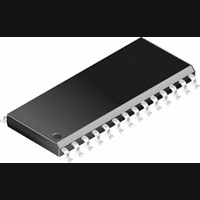CS8420-CS Cirrus Logic Inc, CS8420-CS Datasheet - Page 51

CS8420-CS
Manufacturer Part Number
CS8420-CS
Description
Transceiver IC
Manufacturer
Cirrus Logic Inc
Datasheet
1.CS8420-CS.pdf
(80 pages)
Specifications of CS8420-CS
Audio Control Type
Sample Rate Converter
Supply Voltage Range
4.75V To 5.25V
Operating Temperature Range
-10°C To +70°C
Audio Ic Case Style
SOIC
No. Of Pins
28
Msl
MSL 2 - 1 Year
Frequency Max
108GHz
Bandwidth
20kHz
Rohs Compliant
No
Lead Free Status / RoHS Status
Contains lead / RoHS non-compliant
Available stocks
Company
Part Number
Manufacturer
Quantity
Price
Company:
Part Number:
CS8420-CS
Manufacturer:
CRY
Quantity:
5 510
Company:
Part Number:
CS8420-CS
Manufacturer:
CIRRUS
Quantity:
225
Part Number:
CS8420-CS
Manufacturer:
CRYSTAL
Quantity:
20 000
Company:
Part Number:
CS8420-CS*
Manufacturer:
NEC
Quantity:
700
Company:
Part Number:
CS8420-CSZ
Manufacturer:
CIRRUS
Quantity:
319
Company:
Part Number:
CS8420-CSZ
Manufacturer:
CIRRUS
Quantity:
9 908
Part Number:
CS8420-CSZ
Manufacturer:
CIRRUS
Quantity:
20 000
14.2.1 Pin Description - Hardware Mode 1
Overall Device Control:
DFC0, DFC1 - Data Flow Control Inputs
S/AES - Serial Audio or AES3 Input Select
MUTE - Mute Output Data Input
OMCK - Output Section Master Clock Input
AES3/SPDIF Receiver Interface:
RXP, RXN - Differential Line Receiver Inputs
RMCK - Input Section Recovered Master Clock Output
RERR - Receiver Error Indicator
EMPH/U - Pre-emphasis Indicator Output or U-bit Data Input
DS245PP2
DFC0 and DFC1 inputs determine the major data flow options available in hardware mode, according to
Table 3.
S/AES is connected to ground in hardware mode 1, in order to select the AES3 input.
If MUTE is low, audio data is passed normally. If MUTE is high, then both the AES3 transmitted audio
data and the serial audio output port data is set to digital zero.
Output section master clock input. The frequency must be 256x the output sample rate (Fso).
Differential line receiver inputs, carrying AES3 type data.
Input section recovered master clock output. Will be at a frequency of 256x the input sample rate (Fsi).
This is also a start-up option pin, and requires a pull-up or pull-down resistor.
When high, indicates a problem with the operation of the AES3 receiver. The status of this pin is
updated once per sub-frame of incoming AES3 data. Conditions that cause RERR to go high are: parity
error, and bi-phase coding error, as well as loss of lock in the PLL. This is also a start-up option pin,
and requires a pull-up or pull-down resistor.
The EMPH/U pin reflects either the state of the EMPH channel status bits in the incoming AES3 type
data stream, or is the serial U-bit input for the AES3 type transmitted data, clocked by OLRCK. When
indicating emphasis EMPH/U is low if the incoming data indicates 50/15
otherwise.
s pre-emphasis and high
CS8420
51



















